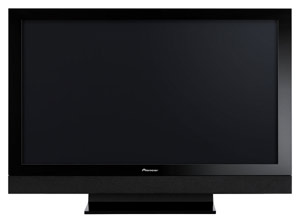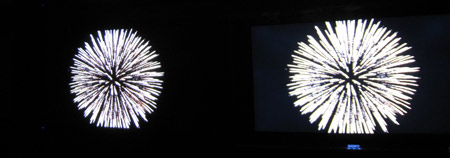At a press event in New York City today, Pioneer announced and displayed the latest entries in their critically acclaimed KURO plasma HDTV line: 50-inch and 60-inch 1080p models which are claimed to produce black levels “5 times deeper” than their predecessors. This would be no mean feat as the current models already set the reference for contrast and black levels in consumer televisions.
At CES earlier this year, Pioneer showed off two KURO concept models: a wafer thin plasma measuring just 0.9 inches deep and an “extreme contrast” model with black levels so good it appeared to absorb ambient room light into a veritable black hole. Objects on the extreme contrast model's screen seemed to float in space and the framing edges of the screen itself were virtually invisible against the black background of the room.

In Japanese, the term “KURO” means “absolute black” and respectable black levels have been the holy grail of displays in any flavor since long before the first plasma or LCD television made it off the assembly line. And the demo I saw today from Pioneer confirms that they are continuing to make incremental improvements in contrast (black levels) without sacrificing other important elements such as picture uniformity and color accuracy. Although the PDP-5020FD demo did not quite have the “wow” effect of the KURO extreme concept television at CES, its black levels were noticeably better than any of the competing brands on display (LCD models from Samsung and Sony and plasma models from Samsung and Panasonic), and even significantly improved from its predecessor, the PDP-5010.


Although we'd hope that most buyers of a high-end display such as this would also invest in a home theater audio system to match but that sad truth is that many flat screen TV users rely on the built-in audio of the television for much if not all of their TV viewing. So Pioneer has enhanced the audio in the Kuro line as well unique sound settings for each of the video settings (standard, movie, sports, performance, game, dynamic), and an auto-volume stabilization feature to equalize audio levels between mismatched channels or between programming and commercials. Also included is an enhancement to their implementation of SRS® WOW HD virtual surround technology called SRS Definition, a high frequency enhancement that provides finer control and adjustment to manage low, mid and high audio frequencies in virtual surround mode.
To provide further enhancements to the picture and sound, the new Pioneer models feature an automatic adjustment feature called Optimum Mode that simultaneously monitors video content and room light conditions. The KURO then automatically optimizes the picture and sound settings to look and sound their best in your specific environment and room lighting. Optimum Mode can of course be defeated by the purists among us.
And in the styling department, the new all-black KURO chassis itself is now just 3.7 inches thick, around 20% thinner than 2007 models.
The two new models the 50-inch PDP-5020 ($4000) and 60-inch PDP-6020 ($5500) are expected to be available in June, 2008.